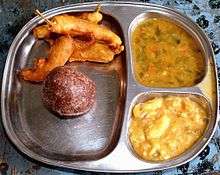Eleusine coracana
| Eleusine coracana | |
|---|---|
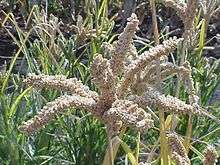 | |
| Scientific classification | |
| Kingdom: | Plantae |
| Clade: | Angiosperms |
| Clade: | Monocots |
| Clade: | Commelinids |
| Order: | Poales |
| Family: | Poaceae |
| Genus: | Eleusine |
| Species: | E. coracana |
| Binomial name | |
| Eleusine coracana | |
| Synonyms[1] | |
| |
Eleusine coracana, or finger millet, is an annual herbaceous plant widely grown as a cereal crop in the arid and semiarid areas in Africa and Asia. It is a tetraploid and self-pollinating species probably evolved from its wild relative Eleusine africana.[2]
Finger millet is native to the Ethiopian and Ugandan highlands.[3] Interesting crop characteristics of finger millet are the ability to withstand cultivation at altitudes over 2000 m above sea level, its favorable micronutrient contents (high iron and methionine content in particular), its high drought tolerance, and the long storage time of the grains.[2]
History
Finger millet originated in East Africa (Ethiopian and Ugandan highlands) and came to India around 2000 BCE. It has been found in an Indian archaeological site dated to 1800 BCE (later Iron Age).[4] In Sri Lanka, it is known as kurakkan or kurahan (කුරක්කන්/ කුරහන්), and is mentioned in legends of ancient kings.
Growing regions
Main cultivation areas are Eastern and Southern African countries (Uganda, Kenya, Zaire, Zimbabwe, Zambia, Sudan, Tanzania, Nigeria and Mozambique) and Southern Asia (mainly India and Nepal).[2]
Climate requirements
Finger millet is a short-day plant with a growing optimum 12 hours of daylight for most varieties. Its main growing area ranges from 20°N to 20°S, meaning mainly the semiarid to arid tropics. Nevertheless, finger millet is found to be grown at 30°N in the Himalaya region (India and Nepal). It is generally considered as a drought-tolerant crop, but compared with other millets, such as pearl millet and sorghum, it preferes moderate rainfall (≥500 mm annually). The majority of worldwide finger millet farmers grow it rainfed, although yields often can be significantly improved when irrigation is applied. In India, finger millet is a typical rabi (dry-season) crop. Heat tolerance of finger millet is high. For Ugandan finger millet varieties, for instance, the optimal average growth temperature ranges at about 27 °C, while the minimal temperatures should not be lower than 18 °C. Relative to other species (pearl millet and sorghum), finger millet has a higher tolerance to cool temperatures. It is grown from about 500 to about 2400 m above sea level (e.g. in Himalaya region). By that, it can be cultivated on higher elevations than most tropical crops. Finger millet can grow on various soils, including highly weathered tropical lateritic soils. Furthermore, it can tolerate soil salinity up to a certain extent. Its ability to bear waterlogging is limited, so good drainage of the soils and moderate water-holding capacity are optimal.[2] Finger millet can tolerate moderately acidic soils (pH 5), but also moderately alkaline soils (pH 8.2).[5]
Cropping systems
Finger millet monocrops grown under rainfed conditions are most common in drier areas of Eastern Africa. In addition, intercropping with legumes, such as cowpea or pigeon pea, are also quite common in East Africa. Tropical Central Africa supports scattered regions of finger millet intercropping mostly with legumes, but also with cassava, plantain, and vegetables.[2]
Most common finger millet intercropping systems in South India are as follows:[6]
- With legumes: Finger millet/dolichos, finger millet/pigeonpea, finger millet/black gram, finger millet/castor
- With cereals: Finger millet/maize, finger millet/foxtail millet, finger millet/jowar, finger millet/little millet
- With other species: Finger millet/brassicas, finger millet/mustard
Weeds
Weeds are the major biotic stresses for finger millet cultivation. Its seeds are very small, which leads to a relatively slow development in early growing stages. This makes finger millet a weak competitor for light, water, and nutrients compared with weeds.[7] In East and Southern Africa, the closely related species Eleusine indica (common name Indian goose grass) is a severe weed competitor of finger millet. Especially in early growing stages of the crop and the weed and when broadcast seeding instead of row seeding is applied (as often the case in East Africa), the two species are very difficult to distinguish.[2] Besides Eleusine indica, the species Xanthium strumarium, which is animal dispersed and the stolon-owning species Cyperus rotondus and Cynodon dactylon are important finger millet weeds.[7] Measures to control weeds include cultural, physical, and chemical methods. Cultural methods could be sowing in rows instead of broadcast sowing to make distinction between finger millet seedlings and E. indica easier when hand weeding.[2] ICRISAT promotes cover crops and crop rotations to discrupt the growing cycle of the weeds. Physical weed control in financial resource-limited communities growing finger millet are mainly hand weeding or weeding with a hand hoe.[7]
Diseases and pests
Finger millet is generally seen as not very prone to diseases and pests. Nonetheless, finger millet blast, caused by the fungal pathogen Magnaporthe grisea (anamorph Pyricularia grisea), can locally cause severe damages, especially when untreated.[2] In Uganda, yield losses up to 80% were reported in bad years. The pathogen leads to drying out of leaves, neck rots, and ear rots.[7] These symptoms can drastically impair photosynthesis, translocation of photosynthetic assimilates, and grain filling, so reduce yield and grain quality. Finger millet blast can also infest finger millet weeds such as the closely related E. indica, E. africana, Digitaria spp., Setaria spp., and Doctylocterium spp.[7][8] Finger millet blast can be controlled with cultural measures, chemical treatments, and the use of resistant varieties. Cultural measures to control finger millet blast suggested by ICRISAT for Eastern Africa include crop rotations with nonhost crops such as legumes, deep ploughing under of finger millet straw on infected fields, washing of field tools after use to prevent dissemination of the pathogen to uninfected fields, weed control to reduce infections by weed hosts, and avoiding of high plant densities to impede the pathogen dispersal from plant to plant.[7] Chemical measures can be direct spraying of systemic fungicides, such as the active ingredients pyroquilon or tricyclazone or seed dressings with fungicides such as trycyclozole.[7][9]
Striga, a parasitic weed which occurs naturally in parts of Africa, Asia, and Australia, can severely affect the crop and yield losses in finger millet and other cereals by 20 to 80%.[10] Striga can be controlled with limited success by hand weeding, herbicide application, crop rotations, improved soil fertility, intercropping and biological control.[11] The most economically feasible and environmentally friendly control measure would be to develop and use Striga-resistant cultivars.[12] Striga resistant genes have not been identified yet in cultivated finger millet but could be found in crop wild relatives of finger millet.[13] ICRISAT is currently evaluating crop wild relatives and will introgress Striga resistance into cultivated finger millet.
Another pathogen of relevance in the finger millet cultivation is the fungus Helminthosporium nodulosum, causing leaf blight.[5]
Important finger millet pests are bird predators, such as quelea in East Africa.[2] The pink stem borer (Sesamia inferens) and the shoot fly (Atherigona milliaceae) are considered as the most relevant insect pests in finger millet cultivation.[5] Measures to control Sesamia inferens are uprooting of infected plants, destroying of stubbles, having a crop rotation, chemical control with insecticides, biological measures such as pheromone traps, or biological pest control with the use of antagonistic organisms (e.g. Sturmiopsis inferens).[14]
Propagation and sowing
Propagation in finger millet farming is done mainly by seeds. In rainfed cropping, four sowing methods are used:[15]
- Broadcasting: Seeds are directly sown in the field. This is the common method because it is the easiest way and no special machinery is required. The organic weed management with this method is a problem, because it is difficult to distinguish between weed and crop.
- Line Sowing: Improved sowing compared to broadcasting. Facilitates organic weed management due to better distinction of weed and crop. In this method, spacing of 22 cm to 30 cm between lines and 8 cm to 10 cm within lines should be maintained. The seeds should be sown about 3 cm deep in the soil.
- Drilling in rows: Seeds are sown directly in the untreated soil by using a direct-seed drill. This method is used in conservation agriculture.
- Transplanting the seedlings: Raising the seedlings in nursery beds and transplant to the main field. Leveling and watering of beds is required during transplanting. Seedlings with 4 weeks age should be transplanted in the field. For early Rabi and Kharif season, seedlings should be transplanted at 25 cm x 10 cm and for late Kharif season at 30 cm x 10 cm. Planting should be done 3 cm depth in the soil
Harvest
Crop does not mature uniformly and hence the harvest is to be taken up in two stages. When the earhead on the main shoot and 50% of the earheads on the crop turn brown, the crop is ready for the first harvest. At the first harvest, all earheads that have turned brown should be cut. After this drying, threshing and cleaning the grains by winnowing. The second harvest is around seven days after the first. All earheads, including the green ones, should be cut. The grains should then be cured to obtain maturity by heaping the harvested earheads in shade for one day without drying, so that the humidity and temperature increase and the grains get cured. After this drying, threshing and cleaning as after the first harvesting.[2]
Storage
Once harvested, the seeds keep extremely well and are seldom attacked by insects or moulds. Finger millet can be kept for up to 10 years when it is unthreshed. Some sources report a storage duration up to 50 years under good storage conditions.[2] The long storage capacity makes finger millet an important crop in risk-avoidance strategies as a famine crop for poor farming communities.[2]
Processing
Milling
As a first step of processing finger millet can be milled to produce flour. However, finger millet is difficult to mill due to the small size of the seeds and because the bran is bound very tightly to the endosperm. Furthermore, the delicate seed can get crushed during the milling. The development of commercial mechanical milling systems for finger millet is challenging. Therefore, the main product of finger millet is whole grain flour. This has disadvantages, such as reduced storage time of the flour due to the high oil content. Furthermore, the industrial use of whole grain finger millet flour is limited. Recently a new milling system was developed in India, which is able to grind finger millet grains. This milling system is called Mini Millet Mill. The Mini Millet Mill takes into account the traditional knowledge of the farmers and moistens the seeds half an hour before grinding. Moistening the millet seeds prior to grinding helps to remove the bran mechanically without causing damage to the rest of the seed. The mini millet mill can also be used to process other grains such as wheat and sorghum. The Mini Millet Mill could be promising as it yields white flour which can be commercially used.[2][16]
Malting
Another method to process the finger millet grain is germinating the seed. This process is also called malting process and is very common in the production of brewed beverages such as beer. When finger millet is germinated, enzymes are activated, which transfer starches into other carbohydrates such as sugars. Finger millet has a good malting activity. The malted finger millet can be used as a substrate to produce for example gluten-free beer or easily digestible food for infants.[2]
Nutrition
Finger millet is especially valuable as it contains the amino acid methionine, which is lacking in the diets of hundreds of millions of the poor who live on starchy staples such as cassava, plantain, polished rice, or maize meal. Finger millet can be ground and cooked into cakes, puddings or porridge. The grain is made into a fermented drink (or beer) in Nepal and in many parts of Africa. The straw from finger millet is used as animal fodder. It is also used for a flavored drink in festivals.
Nutritional value of finger millet per 100g [17]
- Protein 7.6g
- Fat 1.5g
- Carbohydrate 88g
- Calcium 370mg
- Vitamins - A: 0.48mg
- Thiamine (B1): 0.33mg
- Riboflavin (B2): 0.11mg
- Niacin: (B3) 1.2mg
- Fiber 3g
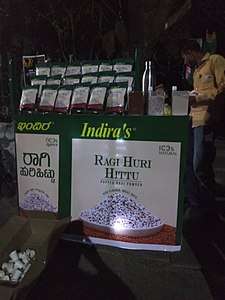
Growing finger millet to improve nutrition
.jpg)
The International Crops Research Institute for the Semi-Arid Tropics (ICRISAT), a member of the CGIAR consortium, partners with farmers, governments, researchers and NGOs to help farmers grow nutritious crops, including finger millet. This helps their communities have more balanced diets and become more resilient to pests and drought. For example, the Harnessing Opportunities for Productivity Enhancement of Sorghum and Millets in Sub-Saharan Africa and South Asia (HOPE) project is increasing yields of finger millet in Tanzania by encouraging farmers to grow improved varieties. Finger millet is very high in calcium, rich in iron and fibre, and has a better energy content than other cereals. These characteristics make it ideal for feeding to infants and the elderly.[18] Recent preclinical study with the finger millet whole grain and bran suggested that finger millet could prevent high-fat diet induced obesity and beneficially modifies the gut bacteria[19]
Preparation as food
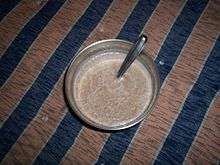
In India
In India, finger millet (locally called by various names including "Ragi" (Kannada: ರಾಗಿ, Telugu: రాగి), "Kezhvaragu" (Tamil: கேழ்வரகு), "Nachani" (Marathi: नाचणी), "Mandua" (Hindi: मंडुआ), "Mandia" (Odia: ମାଣ୍ଡିଆ), "Same" (Bonda: ସାମେ)) is mostly grown and consumed in Karnataka, Rajasthan,[20] Andhra Pradesh, Tamil Nadu,[21] Odisha, Maharashtra, Goa,[22] Uttarakhand (Garhwal and Kumaon districts), and Gujarat (Dang district) [23]
The finger millet is malted and its grain are grinded to form flour. The flour is consumed mixed with milk, boiled water or yogurt. The flour is made into flatbreads, including thin, leavened dosa and thicker, unleavened roti.
There are various food recipes of finger millet, including dosa, idli, laddu etc. In southern India, on pediatrician’s recommendation, finger millet is used in preparing baby food, because of millet’s high nutritional content, especially iron and calcium. Home-made finger millet malt is considered to be very good for health.
Konkan Region and Goa
.jpg)
Finger millet (ragi) is very popular and satva, pole (dosa), bhakri, ambil (a sour porridge), Pappad are very common preparations. Nachani Ladus are common in some families.
Maharashtra
In Maharashtra, bhakri (भाकरी in Marathi), a type of flat bread is prepared using finger millet (ragi) flour. In Mumbai and Navi Mumbai areas, the biscuits prepared with ragi flour are also available in some bakeries. They are getting popular because of their relatively lower calorific value and more fibre as compared to wheat.
Karnataka
In Karnataka, finger millet (ragi) is generally consumed in the form of ragi mudde (balls) (ರಾಗಿ ಮುದ್ದೆ ragi mudde in Kannada). It is the staple diet of many residents of South Karnataka, especially in the rural areas. Mudde is prepared by cooking the ragi flour with water to achieve a dough-like consistency. This is then rolled into 'balls' of desired size and consumed with huli (sambar), Saaru(ಸಾರು), or curries. Mudde (ಮುದ್ದೆ)is cut into biteable sizes using fingers, dipped in the curry preparation and swallowed wholly without biting into the pieces. Ragi is also used to make roti, idli, dosa and conjee. In the malnad region of Karnataka, the whole ragi grain is soaked and the milk is extracted to make a dessert known as "Keelsa".
A type of flat bread is prepared using finger millet (ragi) flour, called ರಾಗಿ ರೊಟ್ಟಿ (ragi rotti in Kannada) in Northern districts of Karnataka.
Tamil Nadu
.jpg)
In Tamil Nadu, ragi is called kezhvaragu (கேழ்வரகு) or just keppai (கேப்பை). Ragi is dried, powdered and boiled to form a thick mass that is allowed to cool. This is the famed kali or keppai kali. This is made into large balls to quantify the intake. It is taken with sambar or thick spicy lentil soups flavored with tamarind extracts. For children, ragi is also fed with milk and sugar (malt). It is also made in the form of pancakes with chopped onions and tomatoes. Kezhvaragu is used to make puttu with jaggery/sugar and adai (by making a thick paste (sweet or salt is used) and tapping it flat on a hot skillet). Apart from that, ragi has its medicinal uses for sinus and severe cold by applying boiled kezhvaragu flour cooled to skin bearable warmth on the forehead.
Ragi is considered to be the holy deity food of Amman, otherwise known as "Goddess Kali". Every small or large festival of this goddess is celebrated with women making ragi porridge in the temples and distributing it to the poor and needy. This porridge is called Koozh - a staple diet in farming communities, eaten along with raw onions & green chillies.
Telangana
In Telangana state, finger millet malt called ambali - is consumed in morning as breakfast.
Andhra Pradesh
In Andhra Pradesh, ragi sankati or ragi muddha (రాగి సంకటి in Telugu) - ragi balls - are eaten in the morning with a chilli, onions, sambar (dish).
Kerala
In Kerala, putu a traditional breakfast dish, is usually made with rice powder with grated coconut and steamed in a cylindrical steamer. The preparation is also made with ragi powder, which is more nutritive.
Central & Northern India
In the tribal and western hilly regions of Odisha, ragi or (ମାଣ୍ଡିଆ) mandiaa is a staple food. The porridge and pitha made of ragi are more popular among village folk.
In the Garhwal and Kumaon region of Uttarakhand, "koda" (कोदा ) or maddua (मंडुआ) is made into thick rotis (served with ghee), and also made as a dish - badi (बाड़ी) - similar to halwa but without sugar. In the Kumaon region of northern India, ragi is traditionally fed to women after child birth. In some parts of Kumaon region the ragi flour is used to make various snacks like Namkeen Sev and Mathri.
In South and Far East Asia
In Nepal
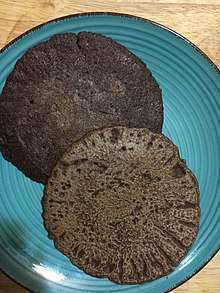
In Nepal, a thick dough (ḍhĩḍo ढिंडो) made of millet flour (kōdō कोदो) is cooked and eaten by hand. The dough, on other hand, can be made into thick bread (rotee रोटी) spread over flat utensil and heating it. Fermented millet is used to make a beer chhaang(छ्याङ) and the mash is distilled to make a liquor (rakśi रक्शी). Whole grain millet is fermented to make tongba(तोङवा). Its use in holy Hindu practices is barred especially by upper castes.
In Sri Lanka
In Sri Lanka, finger millet is called kurakkan and is made into kurakkan roti - an earthy brown thick roti with coconut and thallapa - a thick dough made of ragi by boiling it with water and some salt until like a dough ball. It is then eaten with a very spicy meat curry and is usually swallowed in small balls, rather than chewing. It is also eaten as a soup (kurrakan kenda) and as a sweet called 'Halape'.
In Vietnam
In northwest Vietnam, finger millet is used as a medicine for women at childbirth. A minority use finger millet flour to make alcohol (bacha alcohol is a good drink of the H'mong minority).
As beverage
Ragi malt porridge is made from finger millet which is soaked and shadow dried, then roasted and ground. This preparation is boiled in water and given to children, patients, adults, etc. This is a good substitute for milk powder-based beverages.
Common names for finger millet
- Arabic: tailabon لدخن
- Chinese: 穇子 (Traditional), 䅟子 (Simplified), cǎnzi (pinyin); also 龍爪稷 and 鴨腳粟 (Traditional)
- Danish: Fingerhirse
- Dhivehi: ބިންބި Binbi
- English: Finger millet, African millet, Koracan, Natcheny, Ragi
- Ethiopia: dagussa (Amharic), tokuso (Soddo), barankiya (Oromo)
- French: eleusine cultivee, coracan, koracan
- German: Fingerhirse
- India:
- Assamese: মৰুবা ধান maruba dhan
- Gujarati: બાવટો bavato; નાચણી naachni; નાગલી nagali
- Hindi: मड़ुआ madua/marua; मंडुआ mandua; मड़ुवा maruwa/maduwa; मंडवा mandwa; रागी ragi
- Kannada: ರಾಗಿ ragi
- Kumaon: maddua
- Garhwal: कोदा koda; चूना "choona"
- Konkani: नांचणी naanchani; नासणे/नाचणे nasne/nachne
- Maithili, (Bihar, especially in Mithila region): madua
- Malayalam: പഞ്ഞപ്പുല്ല് ragi;muthary/kuvaraku/kurumbullu/panjipul
- Marathi: नाचणी naachani; नागली naagali
- Odia: ମାଣ୍ଡିଆ mandia
- Himachali: कोद्र kodra
- Punjabi: ਮੁੰਡਲ mandal/mandhul/mundal
- Rajasthani: नाचणी naachni; रागी ragi
- Sanskrit: मधुलिका madhulika; मट्टकम् mattakam; नृत्यकुण्डलक nrityakundala
- Tamil: ஆரியம் aariyam'; கேழ்வரகு kezhvaragu; கேப்பை keppai, ராகி raagi
- Telugu: రాగి ragi;చోళ్ళు chollu; తమిదలు tamidalu
- Urdu: منڐوا mandwa; مڙوا maruwa; راگی ragi
- Japan: 四国稗 シコクビエ shikoku hie shikokubie
- Kenya: wimbi (Swahili), kal (Dholuo), ugimbi (Kikuyu and Meru), obori (Kisii)
- Korea: 수수 susu
- Nepal: कोदो kodo; मड़ुवा maruwa
- Nigeria: tamba (Hausa)
- Rwanda: uburo
- Sri Lanka: කුරක්කන් kurakkan (Sinhala)
- Sudan: tailabon (Arabic), ceyut (Bari)
- Tanzania: Mbege, Mwimbi, Wimbi, Ulezi (Swahili)
- Tibetan: bras ma du lun ga
- Uganda: Bulo, Akalo, Kwon, Kwon Kal
- Vietnam: Hong mi, Chi ke
- Zambia: Kambale, lupoko, mawele, majolothi, amale, bule
- Zimbabwe: Rapoko, zviyo, njera, rukweza, mazhovole, uphoko, poho
- Somalia: Haruur, Masago Yocob
Gallery

.jpg) Finger millet sprays in Uganda
Finger millet sprays in Uganda_BNC_(cropped).png) Multicolored finger millet grains
Multicolored finger millet grains- Fresh ragi
References
- ↑ "The Plant List: A Working List of All Plant Species". Retrieved 8 January 2015.
- 1 2 3 4 5 6 7 8 9 10 11 12 13 14 National Research Council (1996). Lost Crops of Africa: Volume I: Grains. National Academies Press. doi:10.17226/2305. ISBN 9780309049900.
- ↑ A.C. D'Andrea, D.E. Lyons, Mitiku Haile, E.A. Butler, "Ethnoarchaeological Approaches to the Study of Prehistoric Agriculture in the Ethiopian Highlands" in Van der Veen, ed., The Exploitation of Plant Resources in Ancient Africa. Kluwer Academic: Plenum Publishers, New York, 1999.
- ↑ K.T. Achaya (2003). The Story of Our Food. Universities Press. p. 21. ISBN 978-81-7371-293-7.
- 1 2 3 H.D. Upadhyaya; V. Gopal Reddy & D.V.S.S.R. Sastry (2008). "Regeneration guidelines Fingermillet, ICRISAT". Crop Specific Regeneration Guidelines CGIAR – via ICRISAT / CGIAR.
- ↑ Krishna, K.R. (2013). "Agroecosystems: Soils, Climate, Crops, Nutrient Dynamics and Productivity". Apple Academic Press.
- 1 2 3 4 5 6 7 Mgonja, Audi, Manyasa and Ojulong, M. Mgonja, P. Audi, E. Manyasa and H. Ojulong (2011). "INTEGRATED BLAST AND WEED MANAGEMENT AND MICRODOSING IN FINGER MILLET: A HOPE PROJECT MANUAL FOR INCREASING FINGER MILLET PRODUCTIVITY IN EASTERN AFRICA". ICRISAT (International Crops Research Institute for Semi Arid Tropics).
- ↑ Takan JP, Muthumeenakshi S, Sreenivasaprasad S, Talbot NJ (2004). "Molecular markers and mating type assays to characterise finger millet blast pathogen populations in East Africa". Poster Presented at British Mycological Society (BMS) Meeting, "Fungi in the Environment", Nottingham.
- ↑ Sreenivasaprasad S, Takan JP, Mgonja MA, Manyasa EO, Kaloki P, Wanyera N, Okwade AM, Muthumeenakshi S, Brown AE, Lenné JM (2005). "Enhancing finger millet production and utilisation in East Africa through improved blast management and stakeholder connectivity". Aspects of Applied Biology. 75: 11–22.
- ↑ Atera, Evans; Itoh, Kazuyuki (2011-05). "Evaluation of ecologies and severity of Striga weed on rice in sub-Saharan Africa" (PDF). Agriculture and Biology Journal of North America. 2 (5): 752–760. doi:10.5251/abjna.2011.2.5.752.760. ISSN 2151-7517. Check date values in:
|date=(help) - ↑ Haussmann, Bettina I.G; Hess, Dale E; Welz, H.-Günter; Geiger, Hartwig H (2000-06-01). "Improved methodologies for breeding striga-resistant sorghums". Field Crops Research. 66 (3): 195–211. doi:10.1016/S0378-4290(00)00076-9. ISSN 0378-4290.
- ↑ Wilson, J. P.; Hess, D. E.; Hanna, W. W. (2000-10). "Resistance to Striga hermonthica in Wild Accessions of the Primary Gene Pool of Pennisetum glaucum". Phytopathology. 90 (10): 1169–1172. doi:10.1094/PHYTO.2000.90.10.1169. ISSN 0031-949X. PMID 18944482. Check date values in:
|date=(help) - ↑ Kuiper, Eric; Groot, Alexia; Noordover, Esther C.M.; Pieterse, Arnold H.; Verkleij, Joe A.C. (1998). "Tropical grasses vary in their resistance to Striga aspera, Striga hermonthica, and their hybrids". Canadian Journal of Botany. 76 (12): 2131–2144. doi:10.1139/cjb-76-12-2131. ISSN 1480-3305.
- ↑ Samiksha, S. "Pink Stem Borer (Sesamia inference): Nature, Life Cycle and Control".
- ↑ "Finger Millet Farming". Agri Farming India. 2015-05-18.
- ↑ Balasubramanian, S. (2013-10-24). "A machine for dehulling millets". The Hindu.
- ↑ "Eleusine coracana - (L.)Gaertn". Plants For A Future. Retrieved 19 November 2012.
- ↑ Alina Paul Bossuet, Nourishing Communities Through Holistic Farming "Archived copy". Archived from the original on 2015-04-02. Retrieved 2014-01-26. . ICRISAT. Downloaded 26 January 2014.
- ↑ Murtaza, N.; Baboota, R. K.; Jagtap, S.; Singh, D. P.; Khare, P.; Sarma, S. M.; Podili, K.; Alagesan, S.; Chandra, T. S.; Bhutani, K. K.; Boparai, R. K.; Bishnoi, M.; Kondepudi, K. K. (2014). "Finger millet bran supplementation alleviates obesity-induced oxidative stress, inflammation and gut microbial derangements in high-fat diet-fed mice". The British Journal of Nutrition. 112 (9): 1447–58. doi:10.1017/S0007114514002396. PMID 25234097.
- ↑ Rajasthan: by Gopal K. Bhargava, Shankarlal C. Bhatt, p 319
- ↑ "Ragi". Tamilnadu.com. 8 April 2013.
- ↑ Ragi is one of the important crop in the Indian state of Goa
- ↑ "Disrict's Specific Profile".
External links
| Wikimedia Commons has media related to Ragi. |
| Wikibooks Cookbook has a recipe/module on |
- 'Eleusine coracana (L.) Gaertn.'
- Rag(i)s to Riches by Vikram Doctor
- Dressler, S.; Schmidt, M. & Zizka, G. (2014). "Eleusine coracana". African plants – a Photo Guide. Frankfurt/Main: Forschungsinstitut Senckenberg.
